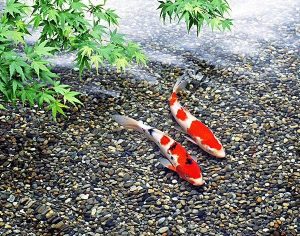How to maintain a villa koi pond
Article source: Ollies (Guangzhou) Recreation and Sports Equipment Co., Ltd Popularity: (Clicked 941 times) Service Hotline: (020)82686289
Koi fish pond in villa garden is not only one of the important elements of the whole landscape, but also a kind of love of life, the combination of static and dynamic design adds vitality and spirit to the quiet courtyard. The colorful and elegant swimming of koi can bring visual enjoyment and stability of mind. At the same time, good management of the fish pond and maintenance of the water quality also reflect the villa owner's pursuit of quality of life and desire for harmonious coexistence with nature.
The management and maintenance of a fish pond is a difficult task for many people. Leaves, debris, silt, fish excreta and bait accumulated in the pond are not cleaned in a timely manner, triggering a series of problems that can leave fish enthusiasts exhausted. Maintaining and cleaning a koi pond is an important task to ensure clean water and healthy koi.

▶Regularly inspect and maintain the fish pond filtration system:
Fish pond filtration system is the key to keep water quality clean. A perfect filtration system includes steps such as UV sterilization, collection, interception, oxygenation, biochemical cultivation and sewage, etc. Regularly check and clean the filter materials, pumps to ensure that they work properly and function.
▶Establishment of a nitrification system:
Nitrifying bacteria help to break down organic matter and harmful substances such as ammonia and nitrite in fish ponds. They prefer to attach and multiply on filter media with high porosity, good interoperability and large surface area.
According to relevant tests, nitrifying bacteria multiply the fastest at around 25°C and are suitable for living in weakly alkaline water. The higher the temperature of the water, the more efficient the nitrifying bacteria are in breaking down ammonia. Koi like weak alkalinity, and as it happens, the higher the pH, the more active the nitrifying bacteria are.
▶Rationalize the depth of the fishpond:
The depth of the fish pond is usually recommended to be over 1 meter, or better 1.5 to 1.8 meters if winterization is a concern. This helps to maintain a stable water temperature and avoids drastic changes in water temperature during the winter.
▶New pool dealkalization treatment:
New concrete ponds need to be dealkalized to avoid the effects of cement on water quality. This can be done with a specialized koi pond paint.
The new pond should be disinfected, washed, changed and raised before putting fish, new fish should be sterilized before entering the pond, pay attention to the temperature of the water, feed less and observe more in the days after entering the pond, and feed normally after a week when there is no abnormality in the physiological characteristics of koi.
▶Choose the right fish pond filtration equipment:
Koi fish pond filtration system should include UV disinfection system, physical filtration, biochemical filtration, oxygenation and bacterial cultivation, sewage, etc., to realize multi-layer filtration, long-lasting ecological purification, and create a healthy and comfortable eco-environment for Koi. It can be a multi-compartment traditional filtration pool, or you can choose an integrated fish pond filter, according to the needs and budget to choose the right one for you.
▶Watch for temperature changes:
Koi is a variable temperature animal, its body temperature changes with the water temperature, and the difference with the water temperature is only 0.5 to 1℃, so its physiological activities and physiological processes are governed by the water temperature.
In the spring it may be necessary to cover with plastic film to keep the water temperature stable; in the summer use shade netting to avoid high water temperatures. Fall is the appropriate season, but be aware of digestive abnormalities and decreased metabolism caused by high temperatures brought on by the fall tigers; in the winter, outdoors in the north will need to consider moving koi indoors.

Colors can vary depending on the water temperature. For example, in the summer when the water is warmer, their body color looks lighter, and conversely, when the water is cooler, the color will be more intense. Sometimes we find that the colors of koi become lighter after we buy them and keep them for a while. This is because most koi stores use well water to keep koi, which has a lower temperature, and when we buy them and keep them in tap water, the temperature is relatively higher, so the colors become lighter.
▶Clean the filtration system:
Depending on the density of fish culture and the amount of feeding, it is recommended to clean the filtration system at least twice a year. If fish density is high, cleaning once every 3 to 5 months is necessary.
▶Upgrade of the filtration system:
With the improvement of the quality of life and fast-paced daily, more and more fish enthusiasts choose automatic integrated fish pond filtration system, automatic cleaning, sewage, no artificial care, free hands to easily do the water is clear fish jump, happy to enjoy!
At the same time, special attention should be paid to the physiological state of koi at high temperatures, the amount of feeding at different times and water quality testing to ensure that the water quality is in a stable and healthy state for a long time.
 Ollies (Guangzhou) Recreation and Sports Equipment Co.
Ollies (Guangzhou) Recreation and Sports Equipment Co.

